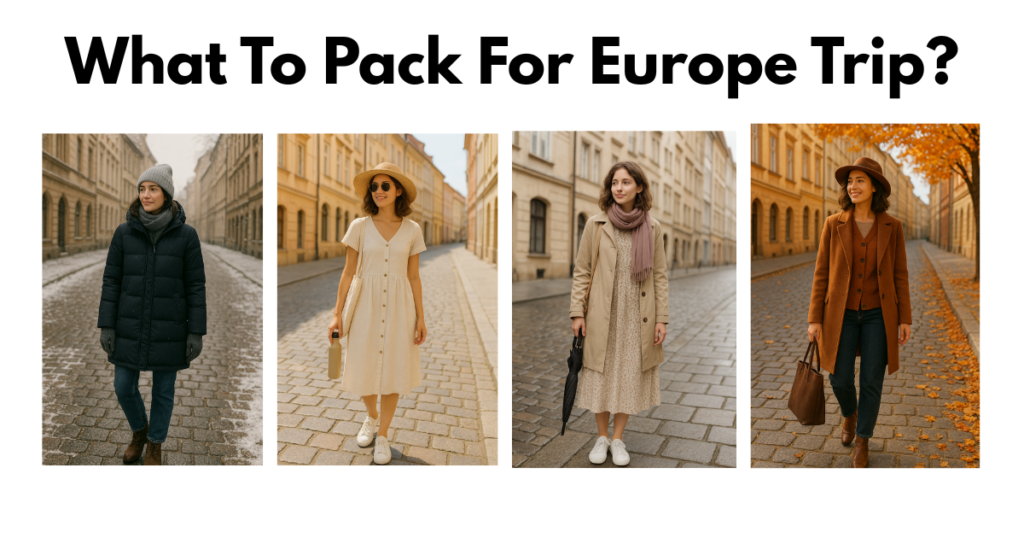Introduction
Packing for a Europe trip can feel overwhelming, especially for first-time travelers. With multiple countries, climates, and cultural norms, deciding what to bring often becomes a challenge. The question most travelers ask is simple yet crucial: what to pack for Europe trip so it’s practical, stylish, and stress-free? Unlike generic packing lists, this guide doesn’t just tell you what items to throw into your suitcase. Instead, it provides strategies, seasonal tips, and real-world advice to ensure you’re well-prepared without overpacking.
Whether you’re wandering through Parisian streets, hiking the Swiss Alps, or exploring the sunny coastlines of Italy, the right packing choices can make or break your trip. Let’s dive into a comprehensive guide to packing smartly for Europe.
Understanding the European Travel Experience
Before deciding what to pack for Europe trip, it’s important to consider the diversity of the continent. Europe isn’t a one-size-fits-all destination. Travelers often visit multiple countries within a single trip, and each destination can bring vastly different experiences.
For example, packing for a week in Rome during summer is different from preparing for a winter holiday in Prague. Similarly, business travelers attending meetings in London may need different essentials compared to backpackers exploring Eastern Europe. Knowing this in advance helps tailor your packing strategy to your specific itinerary.
Clothing Essentials for Europe
Europeans are known for their chic yet practical fashion sense, and blending in with the local style is often a priority for travelers. When considering what to pack for Europe trip, aim for versatile outfits that can be mixed and matched.
Choose comfortable walking shoes since cobblestone streets are common in historic cities. Lightweight layers are key for adapting to varying temperatures across the day. A classic jacket, a few wrinkle-free shirts, and neutral-toned trousers or skirts make it easy to create multiple looks with fewer items. Adding one or two stylish pieces helps you fit right into European urban culture while staying practical.
Seasonal Packing Guide for Europe
Since Europe’s weather varies drastically, the season of travel plays a huge role in deciding what to pack for Europe trip.
Spring (March – May)

Spring brings mild temperatures with occasional rain showers. Lightweight jackets, scarves, and a compact umbrella are smart additions.
Summer (June – August)

Expect hot days, especially in Southern Europe. Light cotton clothing, breathable fabrics, and sun protection like hats and sunglasses are essential. Carry a reusable water bottle to stay hydrated during long sightseeing days.
Autumn (September – November)

Autumn often blends sunny afternoons with chilly evenings. A warm cardigan or light coat paired with boots ensures comfort.
Winter (December – February)

Northern and Central Europe can be extremely cold, requiring heavy coats, gloves, and thermal wear. Southern Europe remains milder, but a warm layer is still recommended.
Travel Gear and Accessories
When considering what to pack for Europe trip, beyond clothes, smart travel gear makes your journey seamless. A sturdy, lightweight suitcase or a convertible backpack ensures easy mobility through airports and train stations. A crossbody bag with anti-theft features is ideal for crowded cities.
Adapters are a must since Europe uses a different plug system than North America or Asia. A portable power bank helps keep your phone and camera charged during long travel days. Packing cubes are another underrated tool, helping you stay organized while moving between destinations.
Packing Smart for Multi-Country Trips
A common mistake travelers make is overpacking for Europe. With so many destinations on one itinerary, it’s tempting to carry outfits for every scenario. Instead, plan for re-wearable clothing and take advantage of laundry services in hotels or local laundromats.
Think in terms of capsule wardrobes – neutral colors, lightweight fabrics, and items that layer well. This reduces baggage weight while giving you flexibility in different climates. Always leave some extra space for souvenirs and shopping since Europe is known for fashion, art, and specialty items you’ll likely want to bring home.
Toiletries and Personal Care Items
Europe has plenty of pharmacies and stores, but packing a basic toiletry kit saves time and money. Include essentials like toothbrush, toothpaste, deodorant, and a small supply of medications. If you wear contact lenses or prescription glasses, bring backups.
Many European airlines have strict liquid restrictions for carry-on bags, so travel-sized bottles are recommended. Solid shampoo bars and refillable travel containers are eco-friendly alternatives that also save space.
Technology and Connectivity
Modern travelers rely heavily on technology, making this a vital section of what to pack for Europe trip. A universal adapter is crucial, as is a SIM card or eSIM for staying connected affordably. Offline maps, translation apps, and digital boarding passes simplify travel logistics.
For photographers or content creators, carrying a lightweight camera or even a high-quality smartphone with extra storage ensures you capture Europe’s beauty without extra bulk.
Cultural Considerations When Packing
Packing isn’t just about comfort; it’s also about respecting cultural norms. Some European churches, such as St. Peter’s Basilica in Rome, require modest clothing. Lightweight scarves and shawls are handy for covering shoulders when needed. In beach destinations like Spain or Greece, casual attire is acceptable, but urban areas often call for more polished looks.
Understanding these nuances ensures you’re not only comfortable but also respectful while traveling.
Safety and Security Essentials
Europe is generally safe, but crowded tourist destinations can attract pickpockets. For this reason, secure backpacks or money belts are worth adding to your list of what to pack for Europe trip. Photocopies of passports, travel insurance documents, and emergency contact information should be kept separately from your originals.
A small first-aid kit with pain relievers, band-aids, and any personal medication ensures peace of mind during unexpected situations.
Sustainable Packing Practices
An often-overlooked aspect of what to pack for Europe trip is sustainability. Europe is leading the charge in eco-friendly travel, so bringing a reusable water bottle, fabric shopping bag, and eco-friendly toiletries aligns you with the culture. Traveling light also reduces carbon emissions when flying or using trains.
By adopting sustainable practices, you not only save money but also contribute positively to the environment.
FAQ Section
What should you avoid packing for a Europe trip?
Avoid bulky items like heavy coats in summer or multiple pairs of shoes. Many hotels provide hairdryers and toiletries, so you can skip those to save space.
How do I pack light for Europe?
Use a capsule wardrobe approach with versatile clothing pieces. Rely on layering, and plan to do laundry during your trip to reduce excess baggage.
Do I need special adapters for Europe?
Yes. Most European countries use Type C, E, and F plugs, and the voltage is 220-240V. A universal travel adapter is highly recommended.
Should I bring cash or cards to Europe?
Both. Credit and debit cards are widely accepted, but it’s wise to carry some cash for small vendors, markets, and public transport.
Is travel insurance necessary for a Europe trip?
Absolutely. Travel insurance covers medical emergencies, lost luggage, and unexpected cancellations, making it an essential part of trip planning.
Conclusion
When planning what to pack for Europe trip, the goal isn’t to pack more but to pack smarter. By focusing on versatile clothing, essential travel gear, cultural awareness, and sustainable practices, you can enjoy a smooth journey without the stress of overstuffed luggage.
Every traveler’s experience in Europe is unique, but with careful preparation, your suitcase can be the key to a hassle-free adventure. So, pack wisely, travel light, and embrace the incredible diversity of Europe with confidence.



